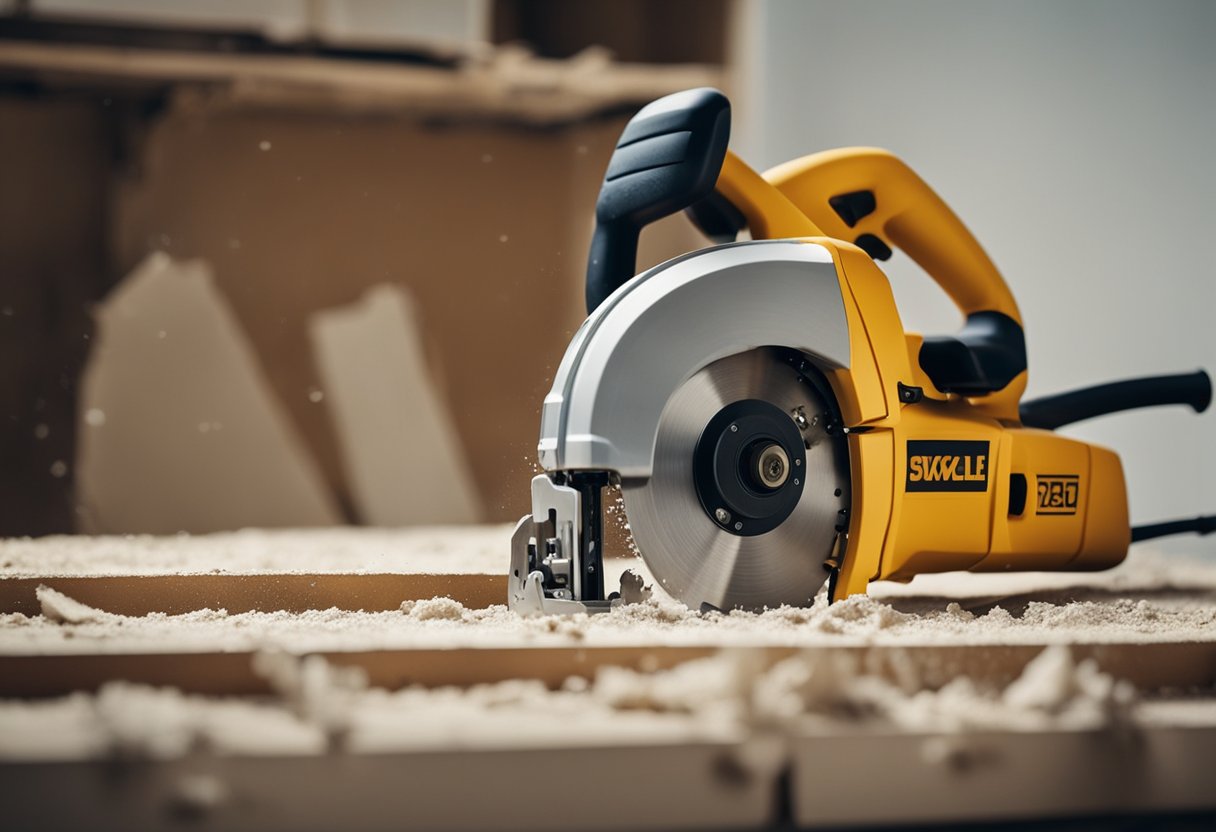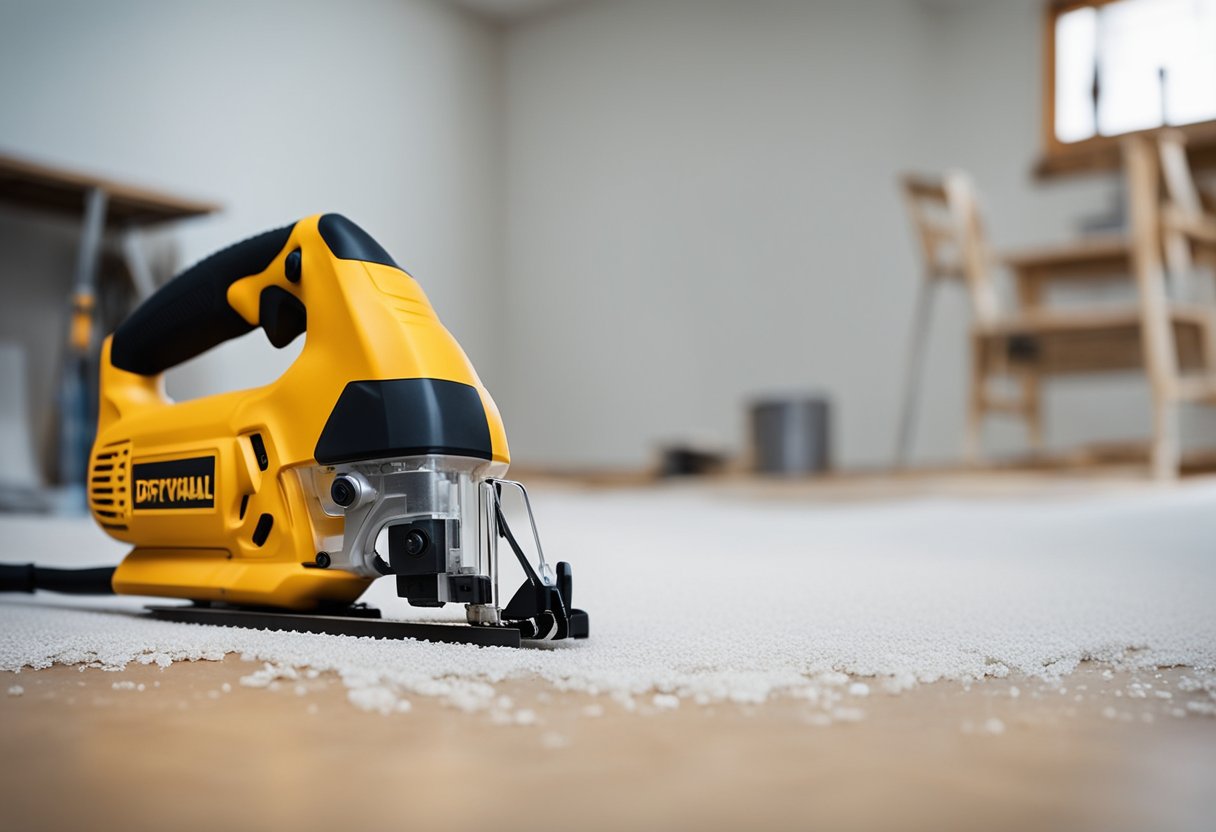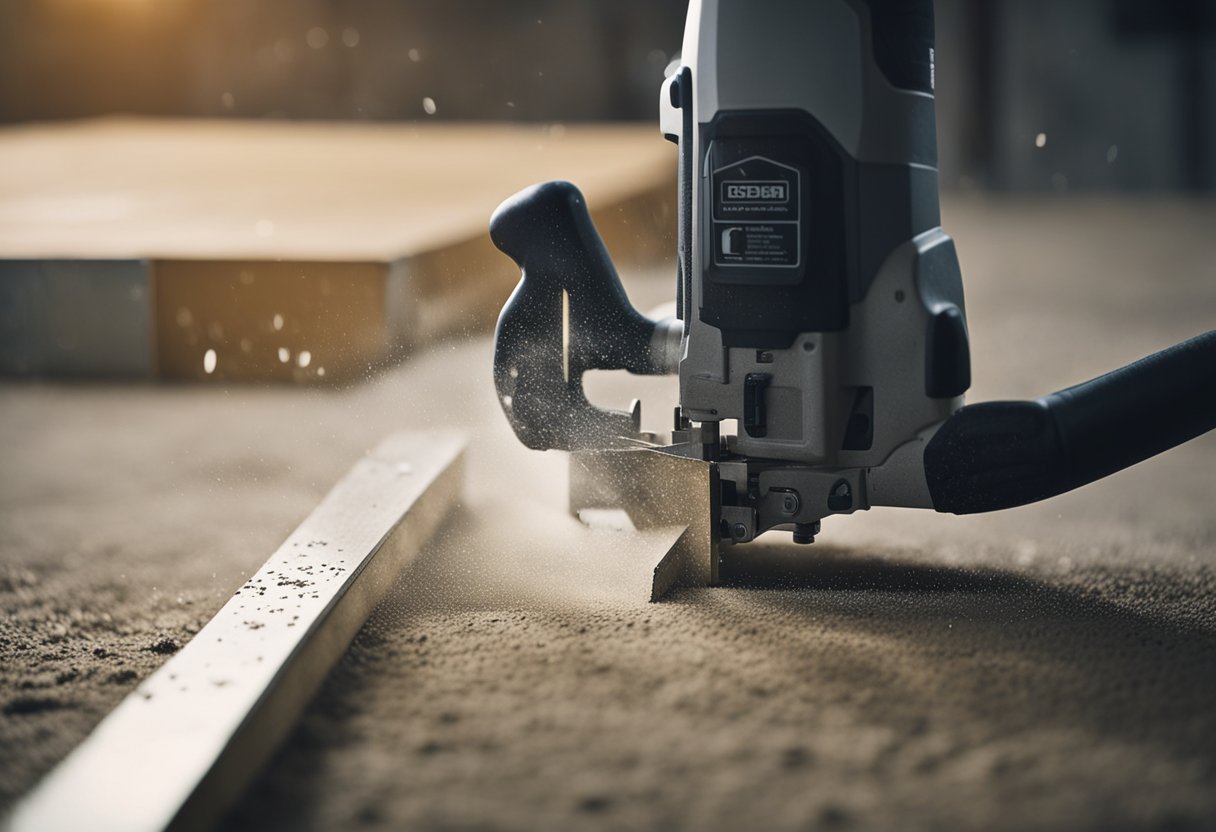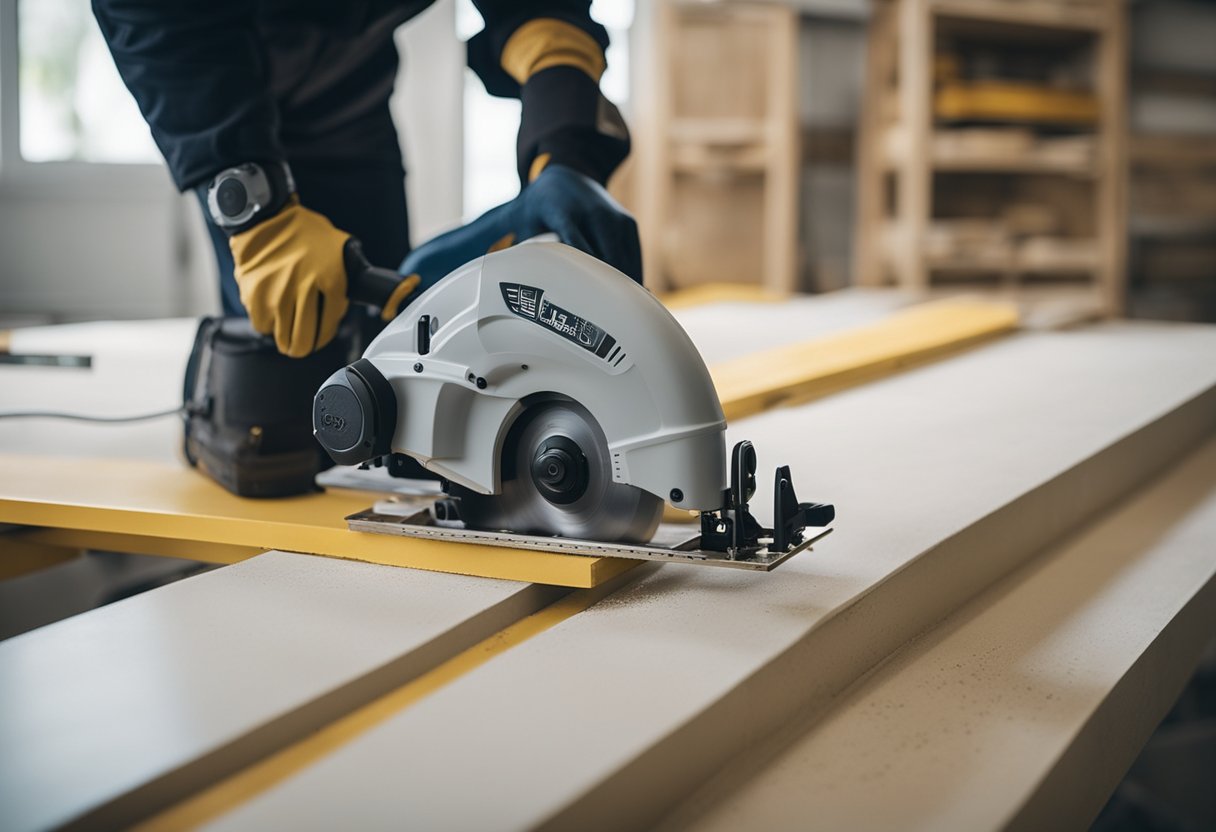Cutting drywall can be a challenging task, but with the right tools and techniques, it can be done with ease. One of the most common tools used for cutting drywall is a jigsaw. A jigsaw is a versatile power tool that can make precise cuts in a variety of materials, including drywall.
Understanding drywall is the first step in cutting it with a jigsaw. Drywall, also known as gypsum board or plasterboard, is a common building material used to create walls and ceilings. It is made of gypsum plaster that is sandwiched between two layers of paper. Drywall is available in various sizes and thicknesses, making it easy to customize for different projects.
Key Takeaways
- Understanding the properties of drywall is essential before cutting it with a jigsaw.
- Having the right tools, including a jigsaw, is crucial for cutting drywall efficiently.
- Proper preparation, cutting techniques, and safety measures are necessary for a successful drywall cutting project.
Understanding Drywall
https://www.youtube.com/watch?v=lI0flDN3M-0&embed=true
As a DIY enthusiast, I know that drywall is an essential material for any home renovation or repair project. It is a common building material made of gypsum plaster that is sandwiched between two sheets of paper. Drywall is also known as gypsum board, plasterboard, or Sheetrock®.
The gypsum core of drywall is the main component that gives it its fire resistance and soundproofing qualities. It is a soft mineral that is mined from the earth and then heated to remove the water content. The resulting powder is then mixed with water to create a paste that is poured between two sheets of paper.
Drywall comes in various sizes and thicknesses, ranging from 1/4 inch to 5/8 inch. The most common size of drywall sheets is 4 feet by 8 feet, but they can also come in 4 feet by 12 feet or 4 feet by 16 feet. The thickness of the drywall sheet depends on the intended use. Thinner sheets are used for curved walls, while thicker sheets are used for walls and ceilings.
One of the benefits of drywall is that it is easy to cut and shape. It can be cut using a variety of tools, including a utility knife, keyhole saw, or jigsaw. When cutting drywall, it is important to use the right tool for the job and to take safety precautions to avoid injury.
Overall, drywall is a versatile and durable material that is used in many construction projects. Understanding the properties and characteristics of drywall is essential for any DIY enthusiast or contractor who wants to achieve professional results in their projects.
Essential Tools for Cutting Drywall
https://www.youtube.com/watch?v=K2XoN2MrraE&embed=true
When it comes to cutting drywall, having the right tools can make all the difference. As someone who has cut drywall with a jigsaw many times, I can attest that having the right tools will not only make your job easier but also produce cleaner cuts. Here are some essential tools you’ll need when cutting drywall:
1. Jigsaw
A jigsaw is a versatile power tool that can be used to cut a wide range of materials, including drywall. When it comes to cutting drywall, a jigsaw is an excellent choice because it allows you to make precise cuts quickly. When choosing a jigsaw, look for one with a variable speed setting and a dust blower to keep your work area clean.
2. Drywall Blade
A drywall blade is a type of saw blade specifically designed for cutting drywall. These blades typically have a medium tooth count, which helps prevent the paper from tearing through. When using a jigsaw to cut drywall, be sure to use a drywall blade for the best results.
3. Drill
A drill is an essential tool for cutting drywall because it allows you to make starter holes in the drywall. Once you have a starter hole, you can use your jigsaw to make the rest of the cut. When using a drill to make starter holes, be sure to use a drill bit that is slightly smaller than the width of your jigsaw blade.
4. Utility Knife
A utility knife is a handheld cutting tool that is perfect for cutting small sections of drywall. When using a utility knife, be sure to use a sharp blade and make multiple passes to avoid tearing the paper surface of the drywall.
5. Reciprocating Saw
If you are cutting a large hole in drywall, a reciprocating saw may be a better choice than a jigsaw. Reciprocating saws are powerful tools that can make quick work of cutting through drywall. When using a reciprocating saw, be sure to use a drywall blade for the best results.
6. Oscillating Multi-Tool
An oscillating multi-tool is another power tool that can be used to cut drywall. These tools are great for making small cuts or cutting out intricate shapes in drywall. When using an oscillating multi-tool, be sure to use a drywall blade for the best results.
7. Hole Saw
If you need to cut a large hole in drywall, a hole saw may be the best choice. Hole saws are designed to make clean, precise cuts and are perfect for cutting holes for electrical boxes or recessed lighting. When using a hole saw, be sure to use a dust mask to protect yourself from the dust created during the cutting process.
In conclusion, having the right tools is essential when it comes to cutting drywall. By using the tools listed above, you can make clean, precise cuts and complete your drywall project with ease.
Preparation Before Cutting
Cutting drywall with a jigsaw can be a daunting task, especially if you are new to DIY projects. However, with the right preparation, you can make the process easier and achieve a professional finish.
Materials
Before starting the project, make sure you have all the necessary materials. You will need drywall, a jigsaw with a suitable blade, and safety equipment such as goggles and gloves. You should also have a pencil, combination square, bubble level, and marking tools.
Marking
Accurate marking is essential for a successful cut. Take your time to ensure that you make precise marks. Use a speed square to mark straight lines, and a combination square to ensure that the angle is correct.
Pilot Hole
Making a pilot hole is essential, especially for door and window openings. Use a drill to make a small pilot hole in the drywall before cutting with a jigsaw. This will help guide the blade and prevent damage to the drywall.
Standard Cuts
For standard cuts, simply press the blade through the material with enough force to create a hole. Be forewarned that it only takes a slight amount of pressure to break through sheetrock so don’t push down too hard on the saw.
Steps
Remember to take your time and follow these steps for a successful cut:
- Measure and mark the drywall accurately
- Make a pilot hole with a drill
- Use a jigsaw to cut the drywall
- Sand the edges for a smooth finish
By following these steps and taking the necessary precautions, you can achieve a professional finish when cutting drywall with a jigsaw.
Cutting Techniques
https://www.youtube.com/watch?v=mHzx2LME0mQ&embed=true
When it comes to cutting drywall with a jigsaw, there are a few techniques you can use to achieve clean and accurate cuts.
Straight Cuts
To make a straight cut, start by marking the line you want to cut on the drywall. Then, align the jigsaw blade with the line and begin cutting. Keep the blade perpendicular to the drywall to ensure a clean cut. You can also use a straight edge or a guide to help you stay on track.
Plunge Cuts
Plunge cuts are useful for cutting out holes or shapes in the middle of drywall sheets. To make a plunge cut, start by drilling a pilot hole at the center of the shape you want to cut out. Then, insert the jigsaw blade into the pilot hole and begin cutting. Make sure to keep the blade aligned with the cut line and use a slow, steady pressure to guide the blade through the drywall.
Rectangular Cuts
For rectangular cuts, start by marking the outline of the shape you want to cut on the drywall. Then, make a series of straight cuts along the outline with the jigsaw. Once you have cut all the way around the shape, use the jigsaw to remove the center section.
Angle and Pressure
When cutting drywall with a jigsaw, it is important to use the right angle and pressure. For straight cuts, keep the blade perpendicular to the drywall and use a steady, even pressure. For curved cuts, adjust the angle of the blade to match the curve of the cut line. Use a light pressure to guide the blade through the drywall.
Score and Snap
Another technique for cutting drywall is to score it with a utility knife and then snap it along the score line. This technique is useful for making long, straight cuts. To score the drywall, use a straight edge to guide the utility knife along the cut line. Then, snap the drywall along the score line by bending it away from the cut side. Use the jigsaw to clean up any rough edges.
By using these cutting techniques, you can achieve clean and accurate cuts in drywall with a jigsaw. Remember to use the right angle and pressure, and to take your time to ensure a straight line.
Safety Measures While Cutting
When it comes to cutting drywall with a jigsaw, safety should always be a top priority. Here are some safety measures that I follow to ensure a safe and successful cutting experience:
Wear Protective Gear
Before starting the cutting process, I always wear protective gear such as safety glasses, hearing protection, and a dust mask. These items help protect me from any flying debris or dust that may be generated during the cutting process. Additionally, I wear safety shoes to avoid any potential injuries caused by falling debris.
Control the Jigsaw
To ensure that the jigsaw is under my control at all times, I use both hands to operate it. This helps me maintain a firm grip on the tool and guide it accurately along the cutting line. Additionally, I make sure that the blade is at an angle to the cutting line but not touching it before starting the tool.
Use the Right Shoe
The shoe of the jigsaw plays an important role in maintaining control while cutting. I make sure that the heel of the shoe is resting on the drywall to provide stability and prevent the blade from wandering off course. Additionally, I turn off the orbital function of the jigsaw before starting the tool to ensure a smooth and accurate cut.
By following these safety measures, I can ensure a safe and successful cutting experience when using a jigsaw to cut drywall.
Post-Cutting Procedures
Once you have finished cutting the drywall with the jigsaw, there are a few post-cutting procedures that you should follow to ensure that the job is done properly.
Clean Up Dust and Waste
Firstly, you should clean up the dust and waste that has been created during the cutting process. Drywall dust can be harmful to your health if inhaled, so it is important to wear a mask and use a shop vac or a vacuum cleaner to remove all the dust and debris from the work area. You can also use a drywall rasp to smooth out any rough edges left by the jigsaw.
Check the Edges
Next, you should check the edges of the cut to make sure that they are smooth and free from any burrs or rough spots. If you find any rough spots, you can use the drywall rasp to smooth them out.
Dispose of Waste Properly
Finally, you should dispose of the waste properly. You can collect the waste in a garbage bag and dispose of it in a landfill. However, if you have a large amount of waste, you may want to consider recycling it. There are many recycling centers that accept drywall waste and will recycle it into new products.
By following these post-cutting procedures, you can ensure that your drywall cutting job is done properly and safely.
Finishing Touches
Once you have cut the drywall using a jigsaw, there are a few finishing touches that you can do to ensure a professional-looking final product.
One thing to keep in mind is the paper flap that may remain after you have made your cut. You can use a drywall square to score the paper flap and then cut it off with a utility knife. This will ensure that the edges are smooth and free of any rough spots.
If you have cut a hole for an electrical outlet or window opening, you may need to use a keyhole saw to make any necessary adjustments to ensure a perfect fit. This tool is also great for cutting out small sections of drywall.
When selecting a jigsaw blade, consider the tooth count. The higher the tooth count, the smoother the cut will be. Additionally, using a blade with an orbital function can help reduce tear-out and improve the overall quality of the cut.
If you are working on a larger drywall project, such as taping and finishing, it is important to ensure that the drywall is properly insulated and framed. This will help prevent any future damage and ensure a long-lasting finished product.
Overall, the versatility of a jigsaw makes it a great tool for cutting drywall in a variety of projects. Just remember to take the necessary precautions, such as wearing eye and ear protection, and always double-check your measurements before making any cuts.
Frequently Asked Questions
https://www.youtube.com/watch?v=TEb7IdWbWKI&embed=true
What is the best tool for cutting drywall?
The best tool for cutting drywall is a jigsaw. It is versatile and can make both straight and curved cuts. Additionally, it is easy to control and maneuver, making it ideal for cutting drywall.
How do you cut plasterboard for sockets?
To cut plasterboard for sockets, you need to measure the size of the socket box and mark the cutout on the plasterboard. Then, use a jigsaw to cut along the marked line. Be sure to wear safety goggles and a dust mask when cutting plasterboard.
Can you use a jigsaw to cut drywall?
Yes, a jigsaw can be used to cut drywall. It is a versatile tool that can make both straight and curved cuts. Additionally, it is easy to control and maneuver, making it ideal for cutting drywall.
What is the difference between cutting drywall with a jigsaw and a circular saw?
A jigsaw is better suited for cutting drywall than a circular saw. This is because a jigsaw is more maneuverable and easier to control, making it ideal for making precise cuts. Additionally, a jigsaw can make both straight and curved cuts, while a circular saw can only make straight cuts.
How do you cut plasterboard in situ?
To cut plasterboard in situ, you need to use a drywall saw or a jigsaw. First, mark the cutout on the plasterboard. Then, use the saw to cut along the marked line. Be sure to wear safety goggles and a dust mask when cutting plasterboard.
How do you cut a plasterboard ceiling?
To cut a plasterboard ceiling, you need to use a drywall saw or a jigsaw. First, mark the cutout on the plasterboard. Then, use the saw to cut along the marked line. Be sure to wear safety goggles and a dust mask when cutting plasterboard. When cutting a ceiling, it is important to have someone hold the plasterboard in place to prevent it from falling.

Hi, I’m Sal Muller of Tooltrip.com. My DIY experience led me to understand essential power tools for home projects. Tooltrip.com guides enthusiasts and professionals in choosing right tools for any job. I provide concise top tool reviews for easier, efficient DIY.






